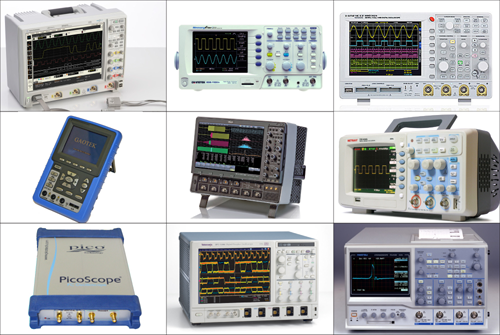
Although you cannot see the electrons moving or the waves in the air, oscilloscopes make you feel the presence of a signal in your electronic circuit. The pictorial representation of the waveforms helps you understand, analyse and debug the waveforms and systems, thus making the oscilloscope a ‘must-have’ device in every lab, be it small or big.
Today, oscilloscopes, also referred to as ‘scopes’ in the industry, are designed not only for viewing signals but also as the solution providers. “The demand for high-speed serial links is increasing. Oscilloscopes have built-in functionalities for electrical compliance and inter-operability test for all different standards. The other wide application is in efficient power supply designs—scope tools help to identify and correct problems quickly and make a reliable product,” shares T. Rajendran, chief technology officer at Primeasure Technologies (a distributor for LeCroy).
“An oscilloscope is the only device that can diagnose the complete health of an electronic circuit by measuring important parameters like wave shape, voltage, frequency and phase angle at any given point of time,” says Chandeep Singh, director, Silicom Electronics.
James Huang, vice president of Goodwill Instruments, believes that the oscilloscope is one of the greatest inventions of the 20th century and the oscilloscope technology has migrated into a new era of digital storage oscilloscopes (DSOs) in the first decade of 21st century.
The scope of oscilloscopes has widened today to serve various technological developments. These have come a long way in terms of internal hardware design, interconnectivity choices for high speed and high bandwidth, and sampling. They have evolved from being a system dedicated to viewing waveforms to an operating-system-based device with various software features.
Wide-band scopes
Bandwidth is the first and most important specification for an oscilloscope. Primarily, to view the waveform and analyse its characteristics, an oscilloscope should be able to cover all the frequency components of the test signal. Scopes available today have bandwidth up to 30 GHz. High-bandwidth scopes are used for microwave testing and RF testing of recent telecom systems like WiMAX, 3G and LTE.
Bandwidth can be defined as the maximum frequency of the signal that can pass though the front-end amplifiers. The bandwidth of the scope must be higher than the maximum frequency that you wish to measure (in real time). If the input is not a pure sine wave, it will contain higher harmonics. For example, a 20MHz square wave viewed on a 20MHz scope is attenuated and distorted.
“To decide the bandwidth, two things are important—fundamental frequency and rise time. The signal may be low-frequency, but if your interest is fast rise time, you need a higher-bandwidth scope than the fundamental frequency. The bandwidth is equivalent to 0.4/RT for DSOs,” shares Rajendran.
[stextbox id=”info” caption=”Parameters for Oscilloscope Selection”]• Number of channels (analogue, digital)
• Bandwidth
• Sampling frequency
• Memory depth
• Triggering
• Signal integrity
• Form factor
• Cost[/stextbox]
Vikram Bhansali, chief executive officer, Arun Enterprises, suggests, “The rule of thumb is to purchase a scope with a bandwidth five times higher than the maximum frequency of the signal you wish to measure.”
“Apart from bandwidth, sampling rate and memory depth are important considerations. These are critical when signal curves are very far away from trigger points. Hence, while selecting a scope, a balance between these three parameters is necessary,” shares P. Prabhu, general manager-technology, Scientific Mes Technik.
“Many a times, high-end scopes have DSP-boosted bandwidth, which contributes to noise. You must carefully look for true bandwidth of the scope while choosing one for your test application,” shares Sanchit Bhatia, digital applications consultant, Agilent Technologies.
Mixed signals have a scope
Mixed-signal oscilloscopes (MSOs) offer analogue analysis capabilities such as standard time, voltage and frequency measurements as well as histograms, waveform maths, Fast Fourier Transform and eye diagrams. “These are hybrid test instruments that combine the usability of an oscilloscope with the measurement capabilities of a logic analyser and some serial protocol analysis,” explains Bhansali.
MSOs are suitable in a mixed-signal environment that has slower analogue signals as well as faster digital control signals. Bhansali shares, “MSOs allow you to view a variety of time-aligned analogue and digital waveforms on the display. Typically, these have two to four analogue inputs and around 16 digital inputs.”
Although MSOs do not provide the full range of advanced digital measurement or full-fledged logic analysis, their less complex working makes them suitable for debugging such hybrid circuits as embedded systems, control systems, analogue-to-digital converters (ADCs) and digital-to-analogue converters (DACs).
“High-speed embedded designs require an oscilloscope to provide integrated high-bandwidth digital channels with analogue channels. Using MSO helps the designers to solve their mixed-signal debug challenges,” justifies Manish Dhruv, applications engineer, Tektronix.
“Today’s embedded boards, apart from analogue signals, have a variety of digital signals such as high-speed SERDES and low-speed serial data (I2C, SPI, UART and RS-232). Multiple inputs/outputs (I/Os) from 16- or 32-bit microcontrollers need to be captured in time correlation for timing analysis on 36 digital channels and four analogue channels that only an MSO can provide at an economical cost,” says Rajendran.






